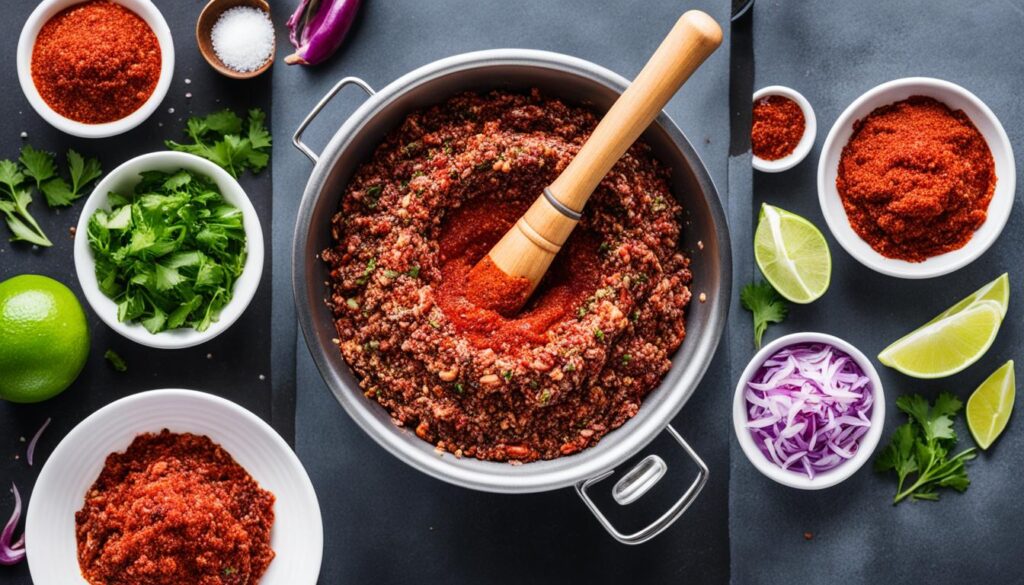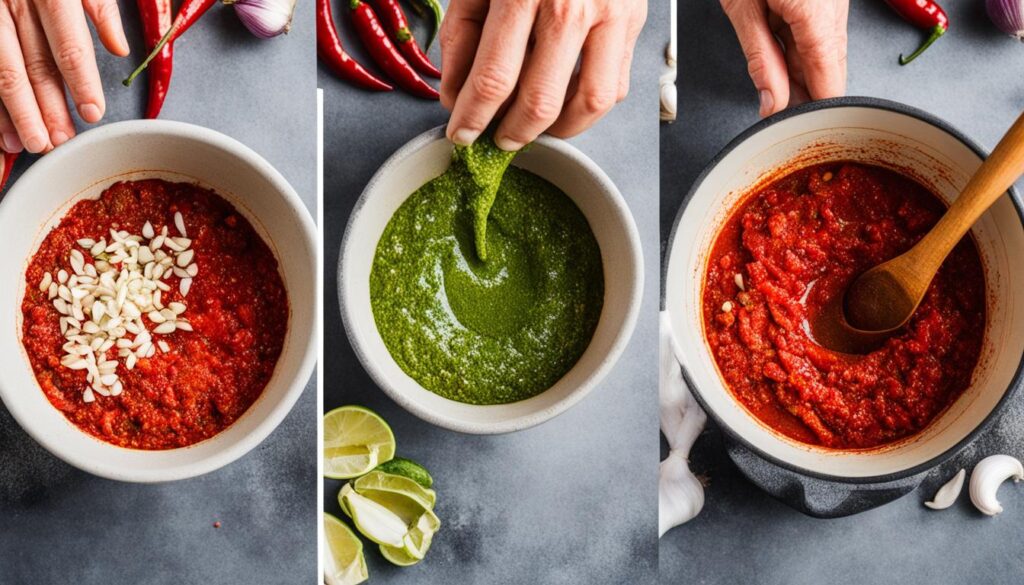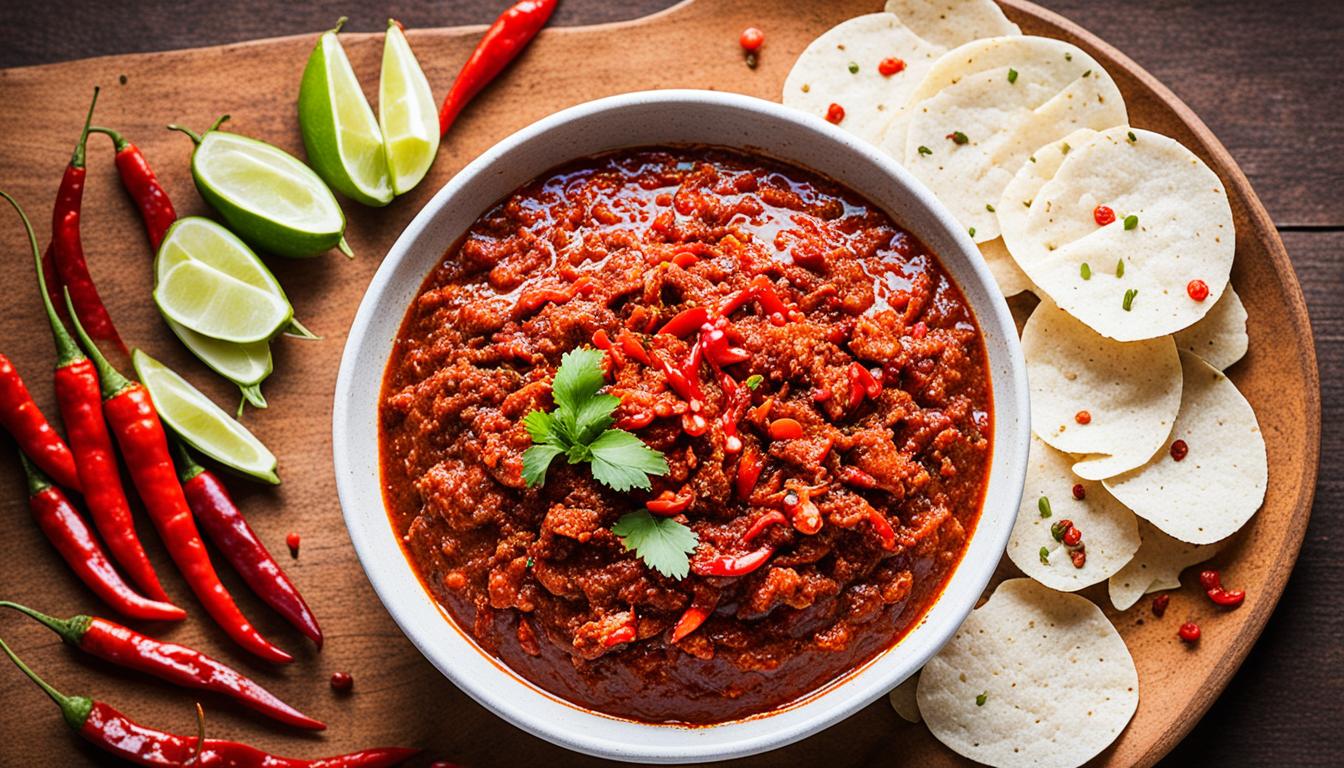Are you ready to embark on a culinary adventure that will ignite your taste buds? Let us introduce you to the tantalizing world of sambal belacan, a Malaysian chile paste that is the epitome of a spicy condiment. But what sets this fiery paste apart from others? What secrets lie within its vibrant red hue? And how can it transform a simple dish into a flavor-packed delight?
Malaysian cuisine is renowned for its bold and vibrant flavors, and sambal belacan is the powerful ingredient that adds an explosive kick to many traditional dishes. Made with chiles, fermented shrimp paste, and a squeeze of lime, this fiery condiment is a staple in Malaysian cooking. But its power goes beyond just heat; sambal belacan brings depth, complexity, and a touch of Southeast Asian magic to any meal.
Key Takeaways:
- Sambal belacan is a traditional Malaysian chile paste that adds fiery flavor to dishes.
- It is made with chiles, fermented shrimp paste, and lime juice, adding depth and complexity.
- There are hundreds of versions of sambal in Southeast Asia, but sambal belacan is the most popular.
- It can be made at home by pounding the ingredients together or conveniently using a blender.
- Sambal belacan is essential in Malaysian cuisine, enhancing the heat and flavor of various dishes.
The History and Varieties of Sambal Belacan
Sambal belacan, a fiery and flavorful Southeast Asian condiment, holds a rich history in the vibrant culinary tradition of the region. Believed to have originated in Java, Indonesia, it later found its way to Malaysia, where it became an integral part of Malaysian cuisine.
Across Southeast Asia, there are numerous versions of sambal, each with its own unique combination of flavors and ingredients. However, sambal belacan stands out as the most popular variation, beloved for its distinct Southeast Asian flavors and traditional recipe.
Sambal belacan is crafted using several key ingredients, including chiles, fermented shrimp paste (belacan), and a tangy squeeze of lime juice. This combination results in a zesty and spicy-savory condiment, perfect for igniting the taste buds and enhancing the heat of any meal.
Sambal belacan’s versatility and intense flavor have made it a staple in Malaysian cooking. It is prominently featured in a wide range of traditional Malaysian dishes, adding an irresistible kick to curries, stir-fries, and noodle dishes.
“Sambal belacan is a beloved part of traditional Malaysian cuisine, cherished for its bold Southeast Asian flavors and its ability to elevate any dish with its fiery heat.”
The Making of Sambal Belacan
Table: Ingredients in Sambal Belacan
| Ingredients | Description |
|---|---|
| Red or green chiles | Spicy or mild options depending on personal preference |
| Fermented shrimp paste (belacan) | Emphasizes the umami flavors and adds depth to the condiment |
| Lime juice | Provides a tangy and refreshing element to balance the spiciness |
Traditional preparation of sambal belacan involves pounding the ingredients together in a mortar and pestle. This method releases the flavors and creates a vibrant, textured paste. However, modern variations also allow for blending the ingredients using a blender or food processor for convenience.
Regardless of the preparation method, sambal belacan showcases the authentic flavors of Southeast Asia, highlighting the bold and aromatic qualities that make it a staple in Malaysian cuisine.
Now that we’ve explored the history and varieties of sambal belacan, it’s time to delve into the ingredients and preparation process of this traditional Malaysian condiment in the next section.
The Ingredients and Preparation of Sambal Belacan
Sambal belacan is a popular and authentic Malaysian dish, known for its fiery flavor and spice. To make this homemade sambal, you will need a few key ingredients:
- Chiles: Choose from different varieties of chiles, such as red chiles for a spicier taste or green chiles for a milder flavor.
- Fermented Shrimp Paste (belacan): Toast the belacan in a skillet until it darkens slightly. This process adds a smoky depth to the sambal’s flavor.
- Lime Juice: A squeeze of lime juice adds tanginess and balance to the spicy chiles and shrimp paste.
While these are the main ingredients, you can also enhance the flavor of your sambal belacan with optional additions such as shallots, garlic, ginger, and tomatoes.
When it comes to preparing sambal belacan, there are a few methods you can choose from. The traditional way involves pounding the ingredients together in a mortar and pestle. This manual technique allows you to control the texture and consistency of the sambal, resulting in a more authentic and rustic taste. However, you can also use a blender or food processor for a quicker and more convenient preparation process.
Regardless of the method you choose, the goal is to create a smooth and well-blended mixture. Once you’ve achieved the desired consistency, taste the sambal and adjust the spice level by adding more chiles if desired. Finally, stir in lime juice and seasonings to taste. Your homemade sambal belacan is now ready to be enjoyed!

How to Make Sambal Belacan at Home
Making sambal belacan at home is a straightforward process that allows you to enjoy the authentic flavors of this traditional Malaysian dish. By following a traditional recipe, you can create a homemade sambal belacan that captures the fiery and savory essence of this spicy condiment.
Gather the Ingredients
To make sambal belacan, you will need the following ingredients:
- Belacan (fermented shrimp paste)
- Chiles (red or green, depending on your preferred level of spiciness)
- Lime juice
- Optional: shallots, garlic, ginger, tomatoes
Toast the Belacan
Start by toasting the belacan in a skillet over low heat until it darkens slightly and becomes fragrant. This step enhances the smoky flavor of the shrimp paste.
Prepare the Chiles
If you prefer a milder sambal belacan, remove the seeds and ribs from the chiles. For a spicier version, leave them intact. Chop the chiles into smaller pieces to facilitate the pounding process.
Pound the Ingredients
Traditionally, sambal belacan is prepared by pounding the ingredients together in a mortar and pestle. This method helps release the flavors and create a smooth paste. However, you can also use a blender or food processor for convenience.
“Pounding the ingredients in a mortar and pestle not only creates a delicious sambal belacan but also allows you to connect with the ancient culinary traditions of Malaysia.” – Malaysian Cuisine Magazine
Add Lime Juice and Seasoning
Once the chiles, belacan, and optional ingredients have been pounded into a smooth paste, taste it and adjust the spice level by adding more chiles if desired. Stir in freshly squeezed lime juice to brighten the flavors. Season with salt or other seasonings to taste.
Store and Enjoy
Your homemade sambal belacan can be stored in an airtight container in the refrigerator for up to a week. Alternatively, you can portion it into smaller containers and freeze them for longer storage. Use your homemade sambal belacan as a condiment, dipping sauce, or flavor enhancer in a variety of authentic Malaysian dishes.

How to Use Sambal Belacan in Malaysian Cuisine
Sambal belacan is a versatile condiment that can elevate the flavors of traditional Malay meals. As a spicy condiment, it adds a fiery kick and depth to various dishes. One of the most common ways to use sambal belacan is as a rice accompaniment in a traditional Malay meal. It is typically served alongside flavorful curries, fried proteins, and blanched vegetables.
Sambal belacan enhances the taste of each spoonful of rice and complements the other dishes on the plate. Its spicy and savory profile adds vibrancy to the entire meal. Whether mixed directly into the rice or enjoyed separately, the spicy condiment brings an extra layer of flavor to the dining experience.
Aside from being a rice accompaniment, sambal belacan can also be used as a dipping sauce for snacks like fried or grilled meats, spring rolls, or fritters. Its bold and intense flavors make it a delightful partner for a variety of savory treats.
Furthermore, sambal belacan can be incorporated into different recipes to infuse them with a spicy twist. It can be added to stir-fries, noodle dishes, or even used to season grilled proteins. The versatility of sambal belacan allows for endless possibilities in the kitchen, offering a gateway to explore and experiment with bold Southeast Asian flavors.
Here are some ways to use sambal belacan in Malaysian cuisine:
- Mix it with rice for a spicy and flavorful rice accompaniment.
- Serve it alongside curries, fried proteins, and blanched vegetables in a traditional Malay meal.
- Use it as a dipping sauce for snacks like fried or grilled meats, spring rolls, or fritters.
- Incorporate it into stir-fries and noodle dishes for an added kick.
- Experiment with it as a seasoning for grilled proteins, such as fish or chicken.
Embrace the bold flavors of sambal belacan and let your taste buds explore the wonders of Malaysian cuisine.
The Cultural Significance of Sambal Belacan
Sambal belacan has a profound cultural significance in Malaysian society, serving as a traditional condiment that embodies the vibrant flavors of Southeast Asia. It holds a special place in Malaysian culture, bringing together the diverse culinary traditions of the region and reflecting the rich heritage of its people.
Each household and family in Malaysia has its own treasured recipe for sambal belacan, passed down through generations. This condiment is more than just a spicy accompaniment; it represents Malaysian identity and is an integral part of authentic Malaysian dishes.
The bold and fiery flavors of sambal belacan reflect the spirit of Malaysian cuisine. It is a key ingredient that adds depth, heat, and complexity to various dishes, creating a harmonious blend of Southeast Asian flavors.
“Sambal belacan is not just a condiment, but a symbol of our heritage and cultural pride. Its inclusion in our meals adds a distinct taste that cannot be replicated.”
This traditional condiment is prepared and enjoyed with reverence in Malaysian households, forming an essential element of meals. Its cultural significance transcends mere culinary enjoyment, serving as a reminder of the shared history, traditions, and values of the Malaysian people.
To fully appreciate the cultural significance of sambal belacan, it is important to understand the diversity within Malaysian society. With influences from Malay, Chinese, Indian, and other indigenous communities, Malaysian cuisine is a melting pot of flavors and techniques, offering a truly unique gastronomic experience.
The use of sambal belacan reflects the values of unity and harmony embraced by the Malaysian people. Regardless of ethnic background or cultural heritage, sambal belacan unites Malaysians through the shared love for its bold and spicy flavors.
The Role of Sambal Belacan in Malaysian Festivities
Sambal belacan is not only a condiment enjoyed in everyday meals but also plays a significant role in Malaysian festivals and celebrations. It adds an extra layer of excitement and flavor to special dishes prepared during festive occasions.
During festive seasons like Hari Raya, Chinese New Year, and Deepavali, sambal belacan is incorporated into traditional dishes to enhance the festive spirit and create a truly memorable dining experience. It is a testament to the cultural unity and diversity of Malaysia, celebrating the unique heritage of its people.
The Legacy of Sambal Belacan
As Malaysian cuisine gains recognition on the global stage, sambal belacan stands out as a distinct and treasured flavor. Its unique combination of chiles, fermented shrimp paste, and Southeast Asian spices elevates dishes to new heights, enticing taste buds with its fiery allure.
The legacy of sambal belacan extends beyond the borders of Malaysia, attracting adventurous food enthusiasts and chefs around the world. Its cultural significance and Southeast Asian flavors continue to captivate palates, bringing a taste of Malaysian cuisine to international kitchens.
Conclusion
Sambal belacan is a must-have spicy condiment for lovers of authentic Southeast Asian flavors. Its fiery taste, rich history, and cultural significance make it an essential ingredient in Malaysian cuisine. Whether homemade or store-bought, sambal belacan adds a unique and vibrant element to dishes and is a true delight for those who enjoy the heat of spicy chiles.
So dive into the fiery world of sambal belacan and explore the diverse flavors of Malaysia. Incorporate this Malaysian chile paste into your cooking, and transport yourself to the vibrant streets and lively markets of Southeast Asia. From traditional Malay meals to stir-fries and noodle dishes, sambal belacan will elevate your culinary creations with its intense and complex flavors.
Indulge in the Southeast Asian flavors and let sambal belacan be your guide to a tantalizing journey through Malaysian cuisine. Discover the art of balancing heat and depth, and experience the cultural significance that this cherished condiment holds in Malaysian culture. So go ahead, add a touch of sambal belacan to your next meal and savor the bold and spicy essence of Malaysia.
